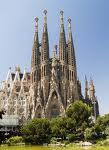
When completed, the Sagrada Familia in Barcelona will be the tallest church building in the world and will have the tallest spire of any church in the world.
It will, however, also be a metre shorter than Montjuic, a nearby hill, as the architect, Antoni Gaudi, was determined that his work should not surpass that of God.
Gaudi was not the first designer commissioned to work on the Sagrada Familia but few projects and architects are more closely associated than Gaudi and his ambitious masterpiece.
Initially, Francesc del Villar was appointed to oversee the construction of the church in 1882 but he resigned after a year due to disagreements with the backers and the commission was passed on to Gaudi in 1883.
del Villar’s was due to be a rather simple neo-Gothic design and Gaudi originally intended to see the project through using an outline very similar to del Villar’s.
By 1889 the crypt was completed and construction on the main body of the building was due to begin. However, just as the next stage of the project was to start the church received a huge donation that prompted Gaudi to have another look at the design of the church.
He discarded the neo-Gothic outline in favour of a monumental structure that would incorporate Modernist elements and be loaded with symbolism.
Gaudi intended his new church to be nothing less than a catechistic explanation of the teaching of the Gospels and the Catholic Church.
He realised that the ambition of the new project put it’s completion beyond his own lifetime and worked on other buildings and commissions alongside the Sagrada Familia. However, in 1914 Gaudi decided to concentrate all his energies on his church and he completed no other major works after this point.
By 1926 Gaudi was living in a room next to his workshop and was devoting all of his time to the Sagrada Familia. He cared little for his appearance and carried little money except for what he needed to buy food.
On July 7th of that year Gaudi was hit by tram in Barcelona. Due to his dishevelled appearance and the lack of money about him he was dismissed as a vagrant and cab drivers refused to take him to hospital. Eventually he made it to a pauper’s hospital where he was unrecognised until his concerned friends manage to track him down the next day.
They arranged for him to be transferred to a better hospital but Gaudi refused saying ‘I belong here among the poor.’
Antoni Gaudi died on the 10th of July 1926 and is buried in the crypt of the Sagrada Familia.
Work continued on the church using the detailed plans that Gaudi had left behind.
In 1938, during the Spanish Civil War, anarchists destroyed Gaudi’s workshop which contained all his plans and models for the Sagrada Familia.
The church is now being completed based on reconstructed versions of Gaudi’s plans and modern adaptations.
The Sagrada Familia is due to be consecrated by Pope Benedict XVI on November 7th 2010.
Construction is due to be completed by 2026.
When challenged by critics who complained about the proposed length of the construction of the church Gaudi replied simply:
‘My client is not in a hurry...’


